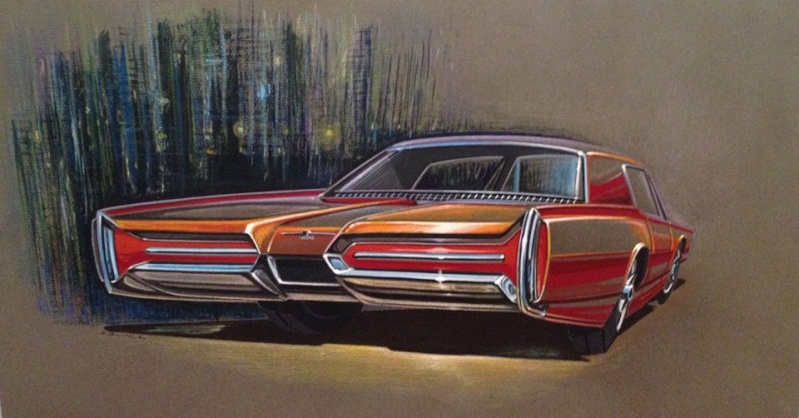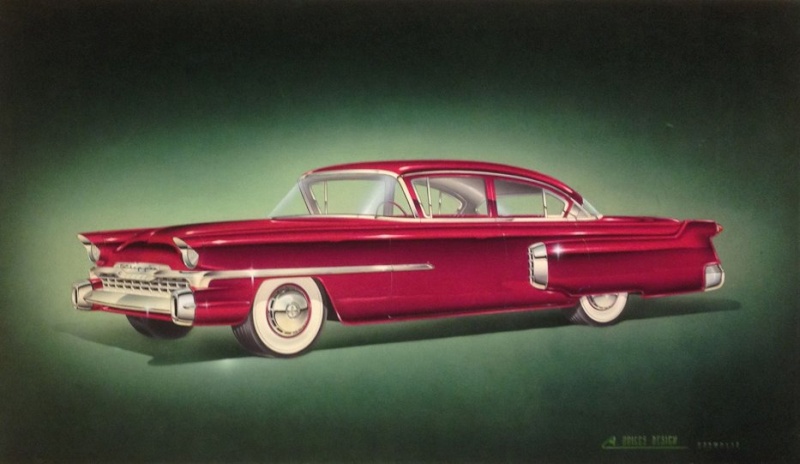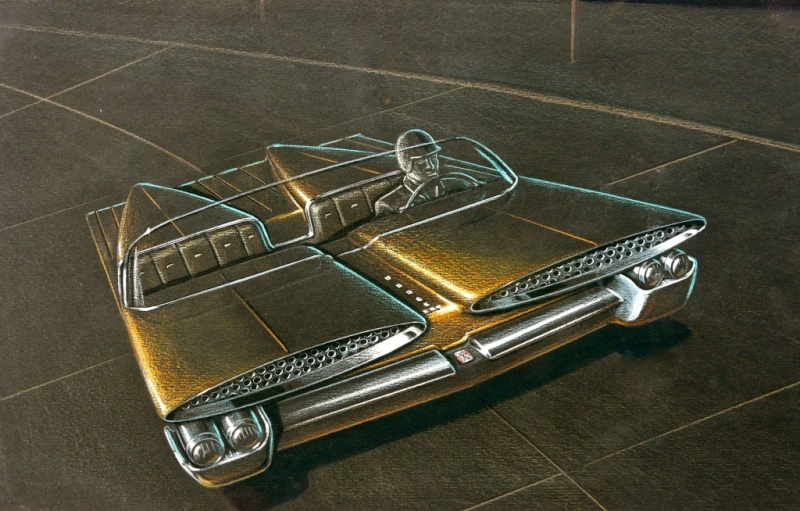Prototype, maquette et exercice de style - concept car & style
4 participants
Page 2 sur 4 •  1, 2, 3, 4
1, 2, 3, 4 
 Re: Prototype, maquette et exercice de style - concept car & style
Re: Prototype, maquette et exercice de style - concept car & style
Al Borst was a GM designer in the early 1950’s.
Airbrush renderings of Buick, Cadillac & Oldsmobile concept art. Automotive studio artwork courtesy of the collection of Frank Walton. Later Mr. Borst worked for AMT Corporation where he was art director and created the illustrations for model car kit packaging. Does anyone have any other information on automotive designer, Al Borst?


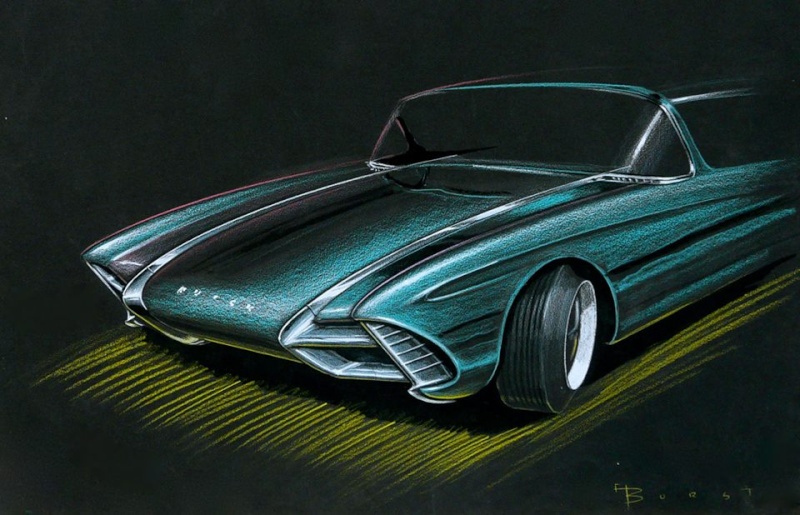
Airbrush renderings of Buick, Cadillac & Oldsmobile concept art. Automotive studio artwork courtesy of the collection of Frank Walton. Later Mr. Borst worked for AMT Corporation where he was art director and created the illustrations for model car kit packaging. Does anyone have any other information on automotive designer, Al Borst?



_________________
We don't care the People Says , Rock 'n' roll is here to stay - Danny & the Juniors - 1958
 Re: Prototype, maquette et exercice de style - concept car & style
Re: Prototype, maquette et exercice de style - concept car & style
_________________
We don't care the People Says , Rock 'n' roll is here to stay - Danny & the Juniors - 1958
 Re: Prototype, maquette et exercice de style - concept car & style
Re: Prototype, maquette et exercice de style - concept car & style
_________________
We don't care the People Says , Rock 'n' roll is here to stay - Danny & the Juniors - 1958
 Re: Prototype, maquette et exercice de style - concept car & style
Re: Prototype, maquette et exercice de style - concept car & style
_________________
We don't care the People Says , Rock 'n' roll is here to stay - Danny & the Juniors - 1958
 Re: Prototype, maquette et exercice de style - concept car & style
Re: Prototype, maquette et exercice de style - concept car & style
_________________
We don't care the People Says , Rock 'n' roll is here to stay - Danny & the Juniors - 1958
 Re: Prototype, maquette et exercice de style - concept car & style
Re: Prototype, maquette et exercice de style - concept car & style
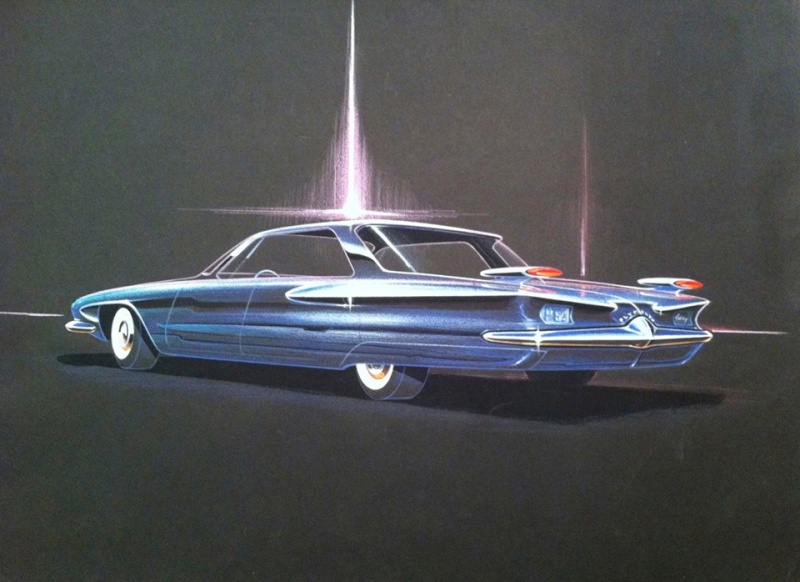
George Krispinsky is one of the heroes of American Automotive art. He was one of the few to work at Ford, AMC, Chrysler AND Packard and he influenced automotive design for decades to come. Chances are if one of these cars is a favorite of yours, he had a role in its design. George is 91 years old now, and we interviewed him for our documentary. You'll love his perspective on the inner culture of the design studios, and insight on the individuals who transformed the automobile into its iconic status in the 1950s, 1960s, and 1970s. Check out this drawing of a Plymouth Fury from George's days at Chrysler. What do you think?
_________________
We don't care the People Says , Rock 'n' roll is here to stay - Danny & the Juniors - 1958
 Re: Prototype, maquette et exercice de style - concept car & style
Re: Prototype, maquette et exercice de style - concept car & style

Wayne Kady, GM automotive designer
drawing signed and dated 1960.
Image courtesy of the “collection of Mark Davis"
Wayne Kady was hired in at GM prior to graduating from the Art Center School of Design (then located in Los Angeles) in 1961. This early artwork shows Kady’s strong sense of following a design theme through in a concept drawing. The ‘belt line’ runs along the side of the car from front to rear in a smooth flowing manner. The bubble top canopy is futuristic yet still plausible. The whole effect is powerful, modern and elegant at the same time. Bill Mitchell, GM’s Vice President of Design from 1958 to 1977 Liked to say he wanted “cars designed to look as if they were going 100 miles per hour standing still”, Kady accomplishes that feeling in this artwork. Wayne Kady worked at GM in various Cadillac Studios, having influenced in particular the highly successful 1971 Eldorado. This artwork was the first piece of automotive art and the beginning of my collecting friend Mark Davis’s superb collection of automotive design.
_________________
We don't care the People Says , Rock 'n' roll is here to stay - Danny & the Juniors - 1958
 Re: Prototype, maquette et exercice de style - concept car & style
Re: Prototype, maquette et exercice de style - concept car & style
John Gump Automotive Stylist for Ford Motor Company
The late John Gump spent the majority of his career at Ford.

The first photo shows him at his drawing board and the second shows his offer of employment letter from Ford, dated October 4th, 1955. John Gump loved to draw cars from an early age. After serving in WWII he began working in the industrial design field. The third photo shows an early drawing of a camper and car with a unique trailer hitch and is dated 1948. He attended Pratt from 1951-54. After being hired in at Ford he helped design concept vehicles, including the Ford Pantera ( a convertible pick-up). The last photo is of an early 1970's LTD. Among his contributions that made it into production were elements of the following; Edsel's, Lincoln's, Thunderbird's, and LTD's. He retired in 1980 from Ford.



The late John Gump spent the majority of his career at Ford.

The first photo shows him at his drawing board and the second shows his offer of employment letter from Ford, dated October 4th, 1955. John Gump loved to draw cars from an early age. After serving in WWII he began working in the industrial design field. The third photo shows an early drawing of a camper and car with a unique trailer hitch and is dated 1948. He attended Pratt from 1951-54. After being hired in at Ford he helped design concept vehicles, including the Ford Pantera ( a convertible pick-up). The last photo is of an early 1970's LTD. Among his contributions that made it into production were elements of the following; Edsel's, Lincoln's, Thunderbird's, and LTD's. He retired in 1980 from Ford.



_________________
We don't care the People Says , Rock 'n' roll is here to stay - Danny & the Juniors - 1958
 Re: Prototype, maquette et exercice de style - concept car & style
Re: Prototype, maquette et exercice de style - concept car & style

Rodell Smith, Automotive Designer
Proposal for the Chrysler New Yorker 1956.
Rodell is 90 years old and a friend of mine. His career as a designer is long and varied. It includes the following companies: Ford (1950-53) Hudson Motor Car Company (1954-55) Packard Motor Car Company (1955) Ford (1956-64) He worked as a product designer from 1964-1972 and then Chrysler from 1972 until he retired in 1989.
Rodell created this artwork in 1956 for his interview at Chrysler. Rodell had hoped to be hired in at Chrysler after Packard closed (being personally thanked when let go by Richard Teague). Rodell updated the New Yorker with subtle changes to the tail fin and front grill. He ended up instead at Ford, designing interiors for the Edsel and devising the color scheme for the Edsel Citation.
Rodell Smith will be filmed for "American Dreaming" later this month. He is one of the only living designers who worked for the Hudson Motor Car Company as well as Packard Motor Car Company.
_________________
We don't care the People Says , Rock 'n' roll is here to stay - Danny & the Juniors - 1958
 Re: Prototype, maquette et exercice de style - concept car & style
Re: Prototype, maquette et exercice de style - concept car & style
Walter Becker, Automotive Designer for Ford Motor Company
Proposal for 1954/55 Mercury tail light.

Automotive designers would draw 100's of variations of every detail of a car. Over the course of the 2 to 3 year lead time required in designing a automobile, final production decisions would be made. None of the three concepts illustrated here were chosen, making this drawing a fascinating document of the visionaries who created the cars. Today automotive designs are created on a computer. The artist, Walter Becker achieved realistic renderings using airbrush in only red, black and white ink allowing the color of the Canson paper to serve as the middle tones. This artwork is from the early 1950's, "Atomic-Age" design was beginning to take hold; rocket-shaped pointed bumpers and tail fins inspired by jet planes would soon appear on automobiles. The standing red light on the chrome mount was definitely influenced by the space-age!

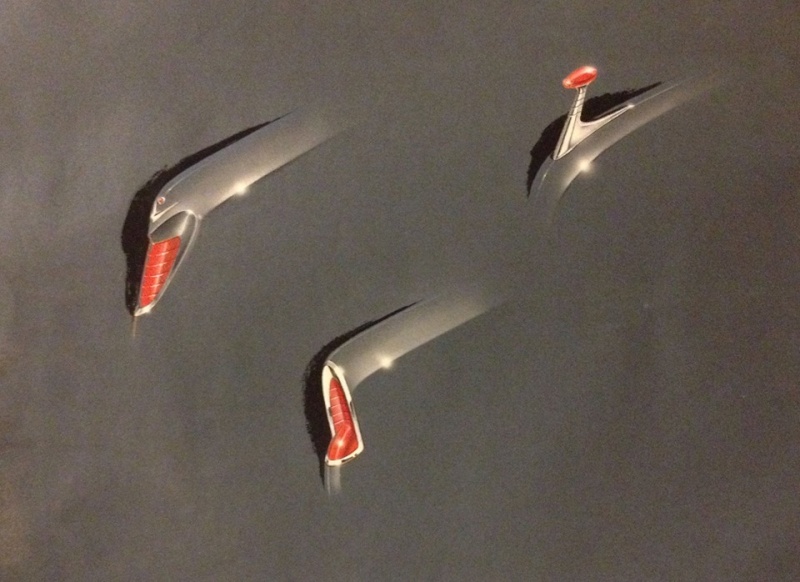
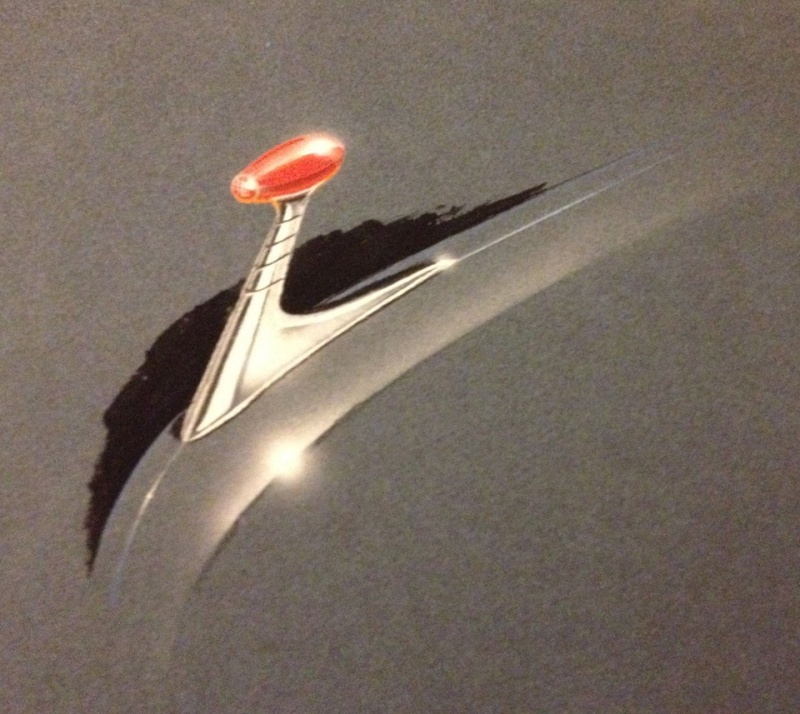
Proposal for 1954/55 Mercury tail light.

Automotive designers would draw 100's of variations of every detail of a car. Over the course of the 2 to 3 year lead time required in designing a automobile, final production decisions would be made. None of the three concepts illustrated here were chosen, making this drawing a fascinating document of the visionaries who created the cars. Today automotive designs are created on a computer. The artist, Walter Becker achieved realistic renderings using airbrush in only red, black and white ink allowing the color of the Canson paper to serve as the middle tones. This artwork is from the early 1950's, "Atomic-Age" design was beginning to take hold; rocket-shaped pointed bumpers and tail fins inspired by jet planes would soon appear on automobiles. The standing red light on the chrome mount was definitely influenced by the space-age!



_________________
We don't care the People Says , Rock 'n' roll is here to stay - Danny & the Juniors - 1958
 Re: Prototype, maquette et exercice de style - concept car & style
Re: Prototype, maquette et exercice de style - concept car & style
Dernière édition par Predicta le Dim 1 Mar - 19:13, édité 1 fois
_________________
We don't care the People Says , Rock 'n' roll is here to stay - Danny & the Juniors - 1958
 Re: Prototype, maquette et exercice de style - concept car & style
Re: Prototype, maquette et exercice de style - concept car & style
_________________
We don't care the People Says , Rock 'n' roll is here to stay - Danny & the Juniors - 1958
 Re: Prototype, maquette et exercice de style - concept car & style
Re: Prototype, maquette et exercice de style - concept car & style
_________________
We don't care the People Says , Rock 'n' roll is here to stay - Danny & the Juniors - 1958
 Re: Prototype, maquette et exercice de style - concept car & style
Re: Prototype, maquette et exercice de style - concept car & style

Designer Dean Swanson took a daring but tasteful approach to what could have been the direction for the Charger / Challenger / Barracuda branded cars of the Chrysler Corporation fleet in this set of three renderings from the late nineteen sixties to early seventies.
Chrysler Plymouth Styling Proposal: Set of Three Illustrations

Artist: Dean Swanson
Year: 1968-1971
Dimensions: 14" x 17" Framed
Price: Set of Three, framed: $7,500.00
Medium: Prisma Color on Artist Papers

_________________
We don't care the People Says , Rock 'n' roll is here to stay - Danny & the Juniors - 1958
 Re: Prototype, maquette et exercice de style - concept car & style
Re: Prototype, maquette et exercice de style - concept car & style
Six styling and color variations on this theme from the mid nineteen fifties by designer A. Borst for General Motors corporation, Detroit Michigan, U.S.A.
Cadillac Sports Coupe / Roadster Concept
Artist: A Borst
Year: Mid 1950s
Dimensions: 26" x 16" Image / Framed
Price: Inquire
Medium: Gouache on Artist's Board
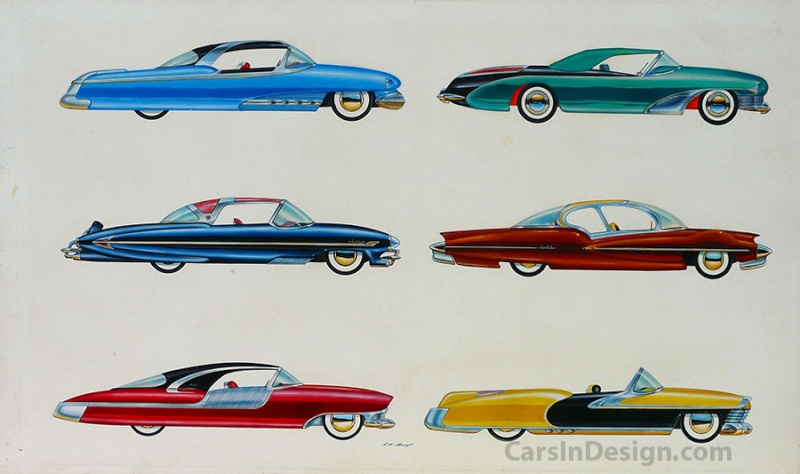
Illustrations Gallery
Dodge Branded Concept Car illustration for sale
Chrysler-styling-proposal-(three)
Cadillac Sports Car Concept
Oldsmobile-sport-roadster-concept-drawing
chevrolet-delivery-van-concept
P1060236
Mining-vehicle-concept-drawing
Ford-LTD-styling-proposal
Mercury-T7-(Cougar)-styling-proposal
Glasstop-Shark-Coupe
P1020196
P1010466-2
_________________
We don't care the People Says , Rock 'n' roll is here to stay - Danny & the Juniors - 1958
 Re: Prototype, maquette et exercice de style - concept car & style
Re: Prototype, maquette et exercice de style - concept car & style
_________________
We don't care the People Says , Rock 'n' roll is here to stay - Danny & the Juniors - 1958
 Re: Prototype, maquette et exercice de style - concept car & style
Re: Prototype, maquette et exercice de style - concept car & style
_________________
We don't care the People Says , Rock 'n' roll is here to stay - Danny & the Juniors - 1958
 Re: Prototype, maquette et exercice de style - concept car & style
Re: Prototype, maquette et exercice de style - concept car & style
_________________
We don't care the People Says , Rock 'n' roll is here to stay - Danny & the Juniors - 1958
 Re: Prototype, maquette et exercice de style - concept car & style
Re: Prototype, maquette et exercice de style - concept car & style

The car which would come to be known to all as the Mercury Cougar takes shape in this rendering by John Gump for Lincoln Mercury Division, Ford Motor Company, Detroit Michigan U.S.A.
Mercury T7 (Cougar) Styling Proposal
Artist: Gump
Year: Dated Nov. 4, 1965
Dimensions: 19" x 25"
Price: $7,500
Medium: Goache on Blue Artist's Paper
_________________
We don't care the People Says , Rock 'n' roll is here to stay - Danny & the Juniors - 1958
 Re: Prototype, maquette et exercice de style - concept car & style
Re: Prototype, maquette et exercice de style - concept car & style
_________________
We don't care the People Says , Rock 'n' roll is here to stay - Danny & the Juniors - 1958
 Re: Prototype, maquette et exercice de style - concept car & style
Re: Prototype, maquette et exercice de style - concept car & style

Designer A. Borst takes aim at the midsize car market with this tasteful, low profile station wagon concept with cityscape for General Motors Corp.
Chevrolet Station Wagon Concept Proposal
Artist: A Borst
Year: Mid-to-late 1950s
Dimensions: 13" x 24" Framed
Price: 14,500
Medium: cut out image overlaid on cityscape / gouache
_________________
We don't care the People Says , Rock 'n' roll is here to stay - Danny & the Juniors - 1958
 Re: Prototype, maquette et exercice de style - concept car & style
Re: Prototype, maquette et exercice de style - concept car & style
Alain , tu vois si je suis au bon endroit 




_________________
" Tu sais que dalle , mon p'tit ...."
Georges LeBay , 1983.
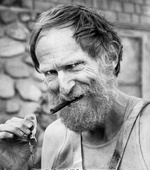
Metalshop16- Messages : 940
Date d'inscription : 12/11/2012
 Re: Prototype, maquette et exercice de style - concept car & style
Re: Prototype, maquette et exercice de style - concept car & style

Radical and innovative approach to design and specifically to headlight configuration and fender treatment, predicts what would become an industry standard in later years. By A. Borst for General Motors corp.
Black Roadster Concept
Artist: A Borst
Year: Mid 1950s
Dimensions: 26" x 16" Image / Framed
Price: Inquire
Medium: Airbrush and Gouache on Artist's Board
Illustrations Gallery
Dodge Branded Concept Car illustration for sale
Chrysler-styling-proposal-(three)
Cadillac Sports Car Concept
Oldsmobile-sport-roadster-concept-drawing
chevrolet-delivery-van-concept
P1060236
Mining-vehicle-concept-drawing
Ford-LTD-styling-proposal
Mercury-T7-(Cougar)-styling-proposal
Glasstop-Shark-Coupe
P1020196
P1010466-2
_________________
We don't care the People Says , Rock 'n' roll is here to stay - Danny & the Juniors - 1958
 Re: Prototype, maquette et exercice de style - concept car & style
Re: Prototype, maquette et exercice de style - concept car & style
Parfait Jerome 

_________________
We don't care the People Says , Rock 'n' roll is here to stay - Danny & the Juniors - 1958
 Re: Prototype, maquette et exercice de style - concept car & style
Re: Prototype, maquette et exercice de style - concept car & style

Rodell Smith started drawing cars in grade school in the early 1930s. More than 80 years later, at 92, he’s still drawing them on the days he feels up to it. Mr. Smith worked nearly 40 years as a professional automotive stylist at Ford and Chrysler, and along with thousands of other mostly unheralded artists and craftsmen, he helped define the look of American progress in an era fueled by 300-horsepower optimism.
Some of the sketches Mr. Smith did then, along with work from more than 100 other stylists, will be on display at “American Dreaming: Detroit’s Golden Age of Automotive Design 1946-1973,” an exhibition running from April 17 through May 2 at Lawrence Technological University in Southfield, Mich.
Today, collectors will pay $150,000 for a 1957 Chrysler 300 convertible in top condition. An exceptional 1959 Cadillac Eldorado Biarritz can fetch as much as $250,000. The sketches that inspired these magnificent sculptures command far less money and attention.
Continue reading the main story
That’s starting to change — at least the attention part. “Planes, Trains and Automobiles,” an exhibition at the Museum of Fine Arts, Boston, that is drawn from the collection of Jean S. and Frederic A. Sharf, features a number of automobile design sketches. At the Christopher W. Mount Gallery in Los Angeles, visitors can see “When the Future Had Fins: Automotive Design and Concepts, 1959-1973.”
“American Dreaming” was organized by Robert Edwards, a Detroit-area collector and documentary filmmaker who had started noticing midcentury design sketches at local garage and estate sales. When he discovered that a number of retired designers lived in his suburb, Royal Oak, his interest grew.
“These were artists who impacted American culture in a huge way,” he said. “But their stories were not being told.”
So about a year ago, Mr. Edwards starting interviewing them. So far, he has amassed 35 hours of footage, and he and a co-producer, Greg Salustro, are now putting together a documentary, also called “American Dreaming.”
In 1950 General Motors had $900 million in net income, a feat that Life magazine described as the “most profitable year of any corporation any time.” That postwar period was heady for Detroit: Incomes were rising; people were moving to the suburbs; and the car, Life said, had emerged as the “most important cachet of social/economic position.”
It was widely understood that what drove sales was what G.M. called “eye appeal.” Hundreds of artists were working in the automaker’s styling section by that point, and every other car manufacturer had styling departments, too.
Because aesthetics were considered the key to sales, these studios were insular realms. Doors were kept locked, and artwork was not allowed to leave the building. When a project was finished, or a design was no longer considered potentially useful, the sketches were destroyed. While the car manufacturers retained some drawings, most of what survives today was smuggled out of the studios by the stylists themselves. Mr. Edwards estimates that around 10,000 sketches still exist from professional stylists working in the golden age.
Continue reading the main story Continue reading the main story
Continue reading the main story
The sketches reflect an America in which foreign competition was virtually nonexistent, and fuel economy was not yet an issue, yet it’s not as if the stylists were working without constraints. Customers had high expectations for roominess and visibility. Engineering concerns established limits for wheelbases and road clearance. Cost was always an issue.
“Every designer has a story where they fought for a particular aspect of design that they weren’t able to get through,” Mr. Edwards said. “The bean counters would step in and say, ‘This is going to be too expensive.’ ”
The collaborative process also meant you could work for years on end and only rarely see your visions come to fruition. Along the way, there would be compromises and disagreements.
“I worked on the Edsel in its preliminary stages,” Mr. Smith said. “I had some long arguments about the front end of that car. My boss thought it should be very prominent so it would be easy to identify. But I always thought it was a little too large and heavy-looking.”
Yet if stylists were somewhat akin to Hollywood screenwriters, unsung and often unable to deliver their dreams to the market intact, what is most apparent in their work is not the compromises, but their spirit of invention, love of speed and power and belief that a car can transform as well as transport.
A 1958 sketch from the stylist George Krispinsky depicts a rocket ship blasting off in the background, yet the Plymouth Fury in the foreground, with its channeled side panels and cantilevered tail fins, looks as if it would be more fun to drive. Wayne Kady’s Cadillac proposals from the early 1960s feature fantastically elongated vehicles that exude an almost predatory menace; trying to park one in a suburban garage would have been like trying to stuff a shark into a goldfish bowl.
These sketches weren’t necessarily supposed to be practical or even technologically feasible; they were meant to stir passionate responses. The goal was to inspire the development of a product so compelling that it would prompt hundreds of thousands of people to say: “This car speaks to me on some deeply personal level. This car embodies some primal part of my soul so fully I will gladly spend half of what I earn a year to own it!”
That was no easy task, yet Detroit’s stylists did it again and again. It was a triumph of industry, and of art.
_________________
We don't care the People Says , Rock 'n' roll is here to stay - Danny & the Juniors - 1958
Page 2 sur 4 •  1, 2, 3, 4
1, 2, 3, 4 
 Sujets similaires
Sujets similaires» The Rover Gas Turbine Car Jet 1 Prototype 1950
» Tasco Prototype by Gordon Buehrig (1948)
» Prototype de la Tucker Still alive
» L' Arbel Symetric Nuclear Car Prototype
» Hot Rod Show World Program, 1970
» Tasco Prototype by Gordon Buehrig (1948)
» Prototype de la Tucker Still alive
» L' Arbel Symetric Nuclear Car Prototype
» Hot Rod Show World Program, 1970
Permission de ce forum:
Vous ne pouvez pas répondre aux sujets dans ce forum
 Connexion
Connexion




